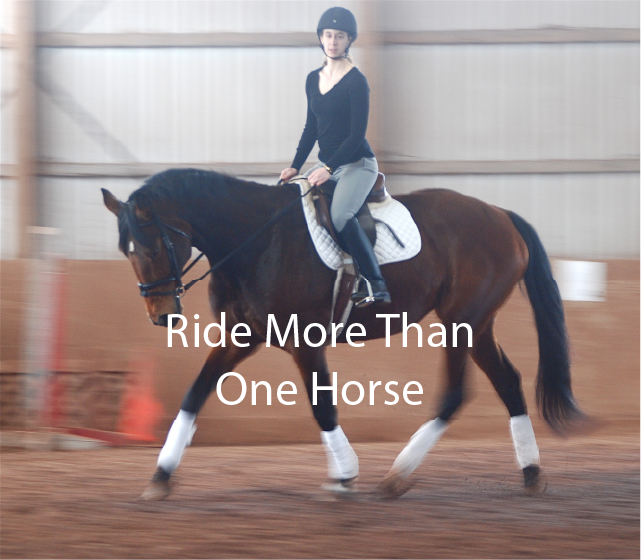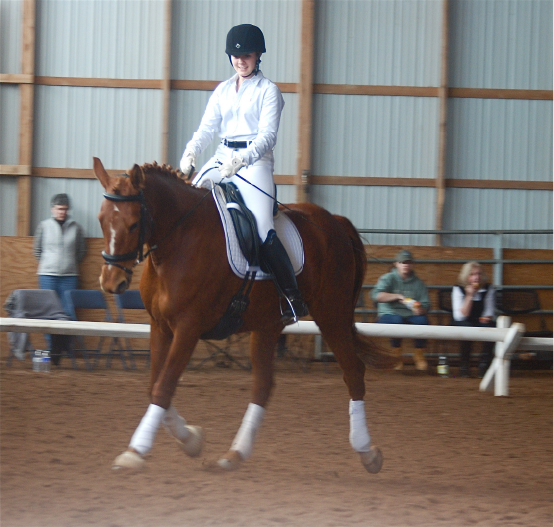Ride More Than One Horse
By Nikki Alvin-Smith

How many times has your student arrived at the barn and requested a particular horse for their lesson? Many students find a horse on your star team of lesson horses that they particularly like to ride and quickly form a bond with it and become perturbed if asked to ride a different beastie.
While it is super to have a student ardent and joyful to come to your barn and lesson, your tolerance of their choice of their favorite horse may quickly have you undone. The horse may become unsound or unfit or for other reasons unavailable for work resulting in the student suspending lessons altogether. The student will not learn to address all their riding issues as they settle too comfortably into the saddle of one particular horse. As the instructor it is always of great benefit to you to see your students on different horses as you will quickly learn or at least confirm (if you didn’t already know and I’m sure you have a keen idea), their foibles and shortcomings as well as their strengths as a rider.
We are all aware that very forward thinking horses are extremely talented at ‘blowing off’ the rider’s legs. Riders stop using their legs and become used to making minimal effort to keep the horse in front of the leg aids if any effort at all. This student will quickly become dependent on their hands and the horse will lean/pull/cajole the rider into whichever gait the horse feels he’d like to enjoy.
When giving a recent dressage clinic my husband Paul {Alvin-Smith} was heard to say,
“Your horse is upset with you because you are not riding her the way she has taught you.”
This evoked some merriment from the auditors. We have all been there. Confession is good for the soul so you might as well just admit that even as an instructor you too have a favorite horse that you look especially forward to riding. So this rule of riding more than one and preferably several different types of horses holds true for you too.
Take the phlegmatic horse. Please! No just kidding. Yes as professionals we all prefer the more forward thinking critter but for a lesson horse the phlegmatic character is a perfect antidote for the nervous rider. These horses train the rider to use their legs and driving aids. The rider will not be hesitant to tap this horse with the whip when it is a needed adjunct to the leg aid. When correctly taught the rider will learn how to have the horse working on the 1/2/3 rule. First forward leg aid a light squeeze, second one an ardent squeeze with the toe turned out for a moment and not leg brought back and if no response? A quick tap with the whip behind the leg with careful allowance to let the horse spring forward. This type of horse is a great confidence builder. If you have a student who is allowing the hotter type of horse to intimidate them and removes their leg aids at the slightest forward motion then simply transfer the student to the phlegmatic horse for a few lessons to make your point that they need to be active and 51 % of the equation in the horse/human partnership.

Horses have very different tolerances to the use of the hand as well as the leg. Everyone can have better hands. Yes. Even you. Your students need to learn the connection between how much leg and seat to use and how much pressure or ‘wall’ to use on the rein in half halts. As every horse has a different conformation and temperament this switch between horses will facilitate quicker progress in learning the balance between driving aids and rein aids.
The variety in conformation of the equine also imparts much help to the student in learning how to use their seat. For work at the sitting trot the smooth gaited horse will encourage the student to relax, the upright shouldered ‘sewing machine’ trot variety will test even the most independent seat.
For jumpers every horse jumps differently. The stride to the fence can be influenced but larger gaited horses may ‘bound around’ in Tigger fashion, while those with stiffer backs may hollow. Some bascule perfectly, some take more encouragement to the obstacle than others. Every horse has a different level of suppleness and athletic ability and it is important that the rider learns to work with all types.
You get the idea. You don’t learn much if you don’t constantly challenge both yourself and your students.
Happy Teaching!
About the author: Nikki Alvin-Smith is an international Grand Prix dressage trainer/clinician who has competed in Europe at the Grand Prix level earning scores of over 72%. Together with her husband Paul, who is also a Grand Prix rider, they operate a private horse breeding/training farm in Stamford, NY.


